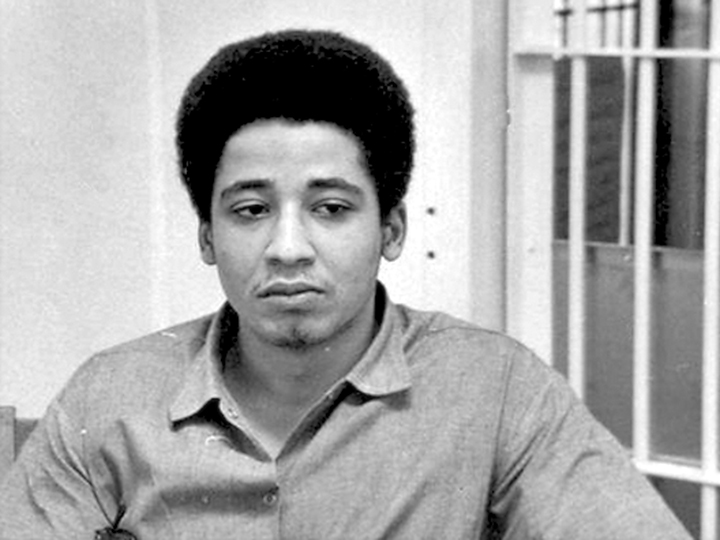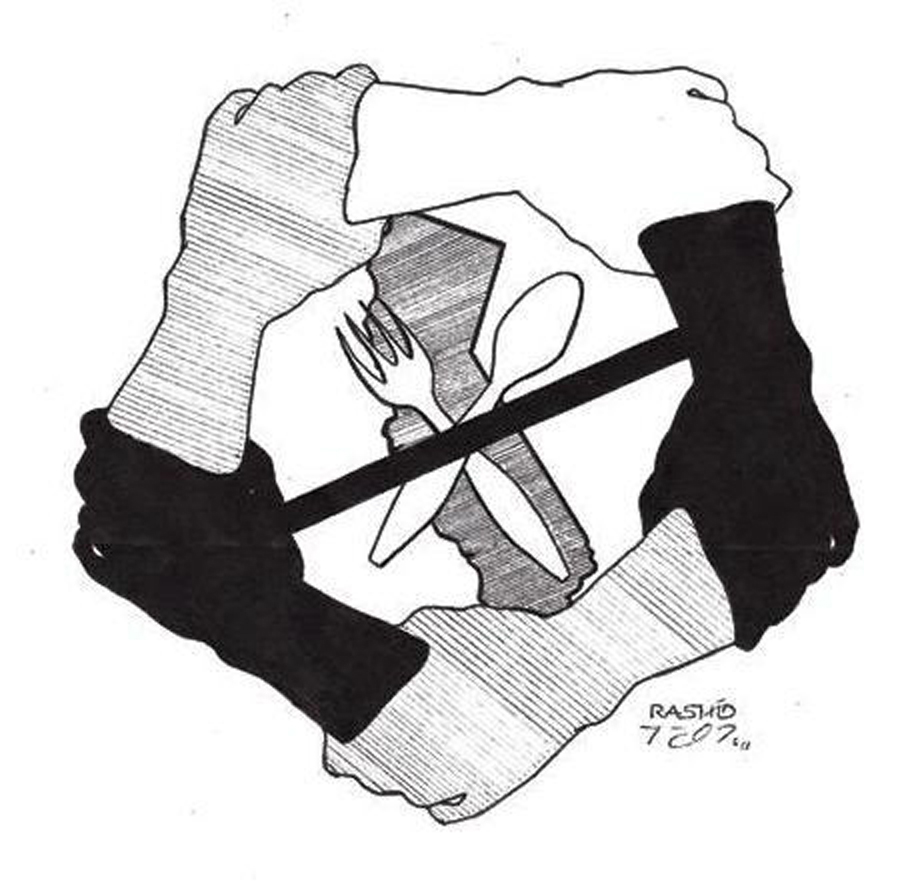From the November-December 2019 issue of News & Letters
Editor’s note: Below we print a talk given in the Bay Area by Faruq in August of 2019.
by Faruq
Once again we are within the month of August, which carries a historic meaning for us, activists and revolutionary thinkers. Naturally we want to participate in practical activities promoting this historical meaning.
Black August Memorial as a concept and a commemoration came into existence in 1979, the year I returned to prison. The idea emerged as a legacy of prisoners, such as W. L. Nolan, Sweet Jug Miller and Cleveland Edwards, who were assassinated on the O-wing yard of Soledad Prison.
O-wing was a notorious lock-up unit, where violence was common. When those prisoners came out to the yard, everyone knew that something would happen. In fact Nolan, Miller and Edwards were attacked by white prisoners. A guard shot into the yard from the tower. A white prisoner was hit with a ricochet bullet and lost his testicle. The three Black prisoners were left to die bleeding out on the concrete.
A CONNECTION TO REVOLUTIONARY PRINCIPLES
A grand jury exonerated the guard who shot the prisoners. Shortly after, a guard was killed at Soledad, supposedly in retaliation for the murders of the three Black prisoners. George Jackson and two others were accused of killing the guard.[1]

George Jackson
A cadre of revolutionary thinkers in Adjustment Center at San Quentin, projected the idea of Black August Memorial in order to reconnect with revolutionary principles of those who made the ultimate sacrifice to liberate oppressed people. George Jackson in particular came to the fore as a leading revolutionary thinker via his writings and discovery of a humanism inseparable from revolution. His life is honored as a martyr who died in a prison revolt of 1971.
What I want to emphasize here is what he said, “Settle your quarrels, come together, understand the reality of our situation, understand that fascism is already here, that people are dying who could be saved, that generations more will die or live poor butchered half-lives if you fail to act. Do what must be done, discover your humanity and your love in revolution.” At that time, coming together was impossible, the racial divides were too great.
These ideas spread, especially among some Black prisoners who internalized them and began to live them. My own engagement with those ideas helped me develop as a human being. My life gained meaning and purpose. I wanted to have a sense of my own history and live with dignity. A consequence for me, and many others, was also a longer prison sentence, as well as two-decades long stint in solitary confinement. It was not any criminal behavior on our part, but just exploring those ideas that got us validated as “worst of the worst.” In my case, the validation was based on having in my possession a San Francisco Bay View article on Black August.
The Black August Memorial expresses the fundamental need to protect and project the history of the people, in this case people of Black Afrikan descent, formerly chattel slaves. As Frantz Fanon put it, “Each generation must, out of relative obscurity, discover its mission, fulfill it, or betray it.” Each one of us is presented with a historical reality. How do you respond? You then have to live with consequences. I can’t see my life without these ideas. There is no middle: you are either fighting against or cooperating with what is.
Black August is a link in our long history of a racially oppressed people’s struggle for freedom. Here are a few of the events we are commemorating: Aug. 21, 1791 was the beginning of the revolution in Haiti. On August 30, 1800, Gabriel Prosser planned to lead Virginia slaves to attack Richmond. In July 1822 Denmark Vesey planned a rebellion in Charleston. Nat Turner’s slave rebellion began on Aug. 21, 1831. Harriet Tubman’s Underground Railroad started in August. The March on Washington took place in August 1963. Watts riot was in August 1965. Jonathan Jackson, James McClain, and William A. Christmas were killed during the Marin Courthouse Rebellion on August 7, 1970. George Jackson was killed during a San Quentin rebellion on August 21, 1971.
New Afrikans displayed a rebellious spirit in all the months of the year. If we cannot easily name a very long list of events that happened in every month, it is only a sign of how much of our history has been lost to us.
THE ESSENCE OF BLACK AUGUST IS IDEA OF HUMANISM
Black August is an attempt to move forward, to discover the idea of freedom for this generation. Black August distinguishes itself from the so-called Black bourgeois political struggle, which has done little to liberate us from racialized oppression, because their form of struggle leads to co-optation.
By contrast Black August does not seek accommodation from the dominant forces. At its core is self-determination, freedom as the ability to control not just our basic needs, such as air, water, food, clothing and shelter, but also the ability to have control of our destiny, to determine the quality of our lives, to determine our activity in our every-day lives.
Black August’s essence is the idea of humanism. The inhumane conditions of prisons in general, and its racist treatment of Black prisoners in particular, birthed resistance. Prisoners reach for their humanity — that is not a hyperbole. Because we are prisoners, convicted of violating some so-called laws of larger society, we are forced to submit to treatment that denies us our human dignity. We are strip-searched, chained, yelled at while standing in line, etc. We could not grow our hair, could not grow a mustache or we got a write-up. Even when we did win some of those personal freedoms regarding our appearance, it still did not afford us full human dignity. We are still subjected to abuse daily. The desire to be fully human is the genesis of Black August.
George Jackson’s response to this entrenched racism was humanism. He urged us, “Settle your quarrels, come together, understand the reality of our situation… Do what must be done, discover your humanity and your love in revolution.” But he was ahead of his time. Only some decades later that idea grew and materialized in the conditions of solitary confinement, when prisoners started talking to each other across racial divides.
We were put in solitary because supposedly we were “the worst of the worst,” the cause of much violence in prison. But after they locked us up, the violence escalated rapidly.
CDCr’s policy of “snitch or die” brought those of us designated as “worst of the worst” together. “Snitch or die” meant that you either snitch on someone or die in solitary, there was no other way out. Being entombed at Pelican Bay security housing units (SHU) had a consequence unintended by prisoncrats, giving us an opportunity to communicate with each other across racial lines.
PRISONERS BREAK WITH RACISM

Hunger strike unity logo created by a Pelican Bay prisoner.
We broke with the racial gang-identification CDCr forced on us. Representatives of each racial group stepped to the fore and came up with the idea of ending hostilities based on race. From those talks came the historic Agreement to End Hostilities.[2] It was a direct challenge to our conditions in solitary and in prison in general.
Those representatives of each group were incredibly courageous. In addition to organizing support for the 2011-13 hunger strikes and participating in them, they faced opposition to accept the Agreement from some of their own people.
It’s important that prisoners accept The Agreement, even if they don’t know the deep history of it. The guards foment resentment between races. The Agreement is not a peace treaty. Its intent is that if you have a dispute with someone, settle it with that individual, don’t get your homeboys to attack him and his homeboys. In those situations, every prisoner loses.
The good news is that The Agreement is still holding. There have been no major events between racial groups. Most of the violence now is due to the yard integration, people in Sensitive Needs Yards being re-introduced into general population.
WE OBJECT TO KILLING OUR MINDS

Includes Faruq’s reports on the historic 2011 hunger strikes against indefinite solitary confinement. To order a copy, click here.
The idea in 2011 hunger strike was to get out of the SHU, to object to being killed, starting with the killing our minds. We may not have believed it was going to work. It was a surprise how many people joined the strike. We knew that we had a few families outside who supported us, but we didn’t really know how many prisoners in general population had joined us, especially in 2013, when CDCr admitted 30,000 joined the hunger strike in many of California’s prisons.
The power of our unity forced CDCr into “damage control.” They had to admit that indeterminate solitary confinement was wrong. They built Pelican Bay for one reason only, to hold people in solitary. To have changed that policy was a real victory for us. Thousands of prisoners were released from solitary. I was released to general population and eventually was able to leave prison altogether.[3]
False constructs broke down, because prisoners recognized something about themselves and their connections with other prisoners, they begun to see each other as human beings. In 2011 we proved that CDCr’s constructed racial divisions are not who we are. The Agreement is expressly cross-racial.
CDCr is not an isolated institution. Fomenting racial divisions are the tools of the capitalist class. Trump and Trumpism is but the latest personification of that tendency. As I mentioned, George Jackson was ahead of his time when he said “fascism is already here.”
Celebrating Black August is an opportunity to re-kindle the struggle for total liberation from racist oppression, and thus set forth a new man and woman. New men and women are people who have purged themselves of the false constructs erected by capitalism.
The idea that freedom is who we are, what we are by nature, keeps reappearing in history in new particular expressions. Isn’t it time to stop looking for quick organizational answers, like a conspiracy, of which Nat Turner was accused? Isn’t it time to stop just hoping only for spontaneous new moments of the idea’s appearance? They are happening now and will certainly continue to come in ever new forms, like, for example, Black Lives Matter. It is time to connect with the idea itself. Nat Turner said it well, when after his apprehension he told his captors: “…but cannot you think that the same idea [freedom] prompted others as well as myself to this undertaking?”
Can the idea that links Black August events, from Nat Turner in 1831 to victory over CDCr in 2011-13, explicitly inform our future?
[1] For more details, see The Melancholy History of Soledad Prison: In Which a Utopian Scheme Turns Bedlam by Min S. Yee, Harper’s Magazine Press, 1973.
[2] For full text of The Agreement in English and in Spanish see https://prisonerhungerstrikesolidarity.files.wordpress.com/2018/03/agreementtoendhostilities_engspan.pdf. If you do not have access to the internet, write to News & Letters, 228 S. Wabash, Room 230, Chicago, IL 60604.
[3] See my articles, “Learning the meaning of parole“, Nov-Dec. 2018 N&L, and “What is freedom?“, July-Aug, 2019 N&L.
